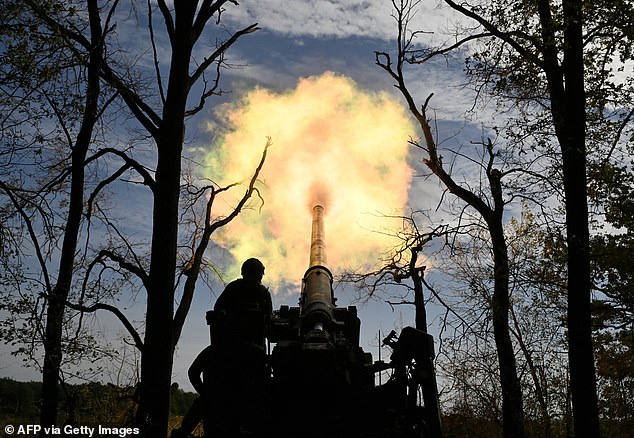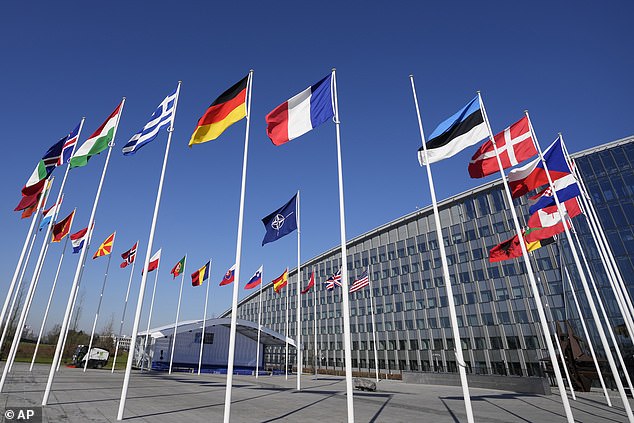NATO members are urgently discussing increasing their defense spending to 3 percent of GDP amid fresh fears about global threats and as Donald Trump threatens to withdraw from the alliance upon his return to the White House.
It comes as the head of the defense alliance warned today that it will be unprepared for the threats it will face from Russia in the coming years if it does not shift to a wartime mindset now.
“Russia is preparing for a long-term confrontation, with Ukraine and with us,” NATO Secretary General Mark Rutte said during a speech in Brussels. “We are not prepared for what awaits us in four or five years.”
He said the time has come for the alliance to “accelerate our defense production and spending,” adding that the current security situation is the worst he has ever seen.
Confidential preliminary talks took place this week about raising the alliance’s 2 percent GDP growth target, a move that could be implemented at its annual summit in the Netherlands in June next year, according to the Financial Times.
President-elect Trump has argued that Europe should pay more for its own defense after declaring he would consider pulling the United States out of NATO if goals were not met.
During his first presidency, Trump demanded more spending during the 2018 NATO summit, and leaders promised to meet the 2 percent goal.
But the spending increase only came in response to Russia’s war against Ukraine, and as a result, non-U.S. NATO members increased their spending by about $100 billion over the past two years.
European NATO members are discussing increasing their defense spending to 3 percent of GDP before Donald Trump returns as president.

The potential move comes amid demands from Trump that Europe should pay more for its own defense.
While the alliance meets the spending target collectively, about a third of its members do not achieve it independently.
This year, only 23 of 32 allies are expected to meet or exceed the 2 percent target.
Seven European countries, including Italy and Spain, still do not comply with the parameter that was first implemented in 2014.
Three people involved in the talks also told the Financial Times that they envisage a short-term commitment to reach 2.5 percent and a target of 3 percent by 2030.
Increasing spending further will be a challenge for several European countries, including the United Kingdom, Spain, Italy, Germany and France.
The UK expects to spend around 2.3 per cent of GDP on defense this year, and the government has confirmed it will increase that figure to 2.5 per cent.
NATO’s founding principle is that an attack on one member is equivalent to an attack on all.
Rutte had previously said he would push for the target to be “much higher” than the current benchmark.
He pointed to what he called a “coordinated campaign to destabilize our societies,” including cyberattacks and assassination attempts orchestrated by foreign powers.
The NATO chief added that the West should keep its eyes open to China’s ambitions and threats towards Taiwan and warned that Beijing is building up its forces “without transparency or limitations.”

NATO Secretary General Mark Rutte holds a press conference at the alliance’s headquarters in Brussels, Belgium, December 4, 2024.
Meanwhile, Ukraine’s President Zelensky has been pushing for membership in the bloc as his country seeks to ensure its future security.
The possibility of kyiv joining the alliance and Western troops being stationed on Ukrainian soil has been deeply divisive and contentious since Russia’s full-scale invasion began on February 24, 2022.
At its summit in Washington in July, NATO declared Ukraine on an “irreversible” path to membership, but stopped short of inviting the country to join.
The United States and Germany have opposed Ukraine joining NATO while it is at war with Russia.
One obstacle has been the view that Ukraine’s borders would need to be clearly demarcated before Ukraine could join so that there was no doubt about where the alliance’s mutual defense pact would come into force.
The invading Russian army occupies about a fifth of Ukraine.
Trump has said the war between Russia and Ukraine would never have started if he had been president and claimed he could end the conflict “within 24 hours,” without ever revealing his plans to do so.
“I can’t give you those plans because if I give them to you, I won’t be able to use them,” he famously said.

President Donald Trump, center, sits with retired Army Lt. Gen. Keith Kellogg, right.

Ukrainian servicemen of the 43rd Artillery Brigade fire a 2S7 Pion self-propelled gun at Russian positions on the front line in the Donetsk region.
In a policy paper released in April, his newly elected envoy, Lt. Gen. Kellogg, acknowledged that a ceasefire would be a bitter pill to swallow for Ukraine but would ultimately be the quickest way to end the bloodshed.
‘The Ukrainian government and people will find it difficult to accept a negotiated peace that does not return all of their territory or, at least for now, hold Russia accountable for the carnage it inflicted on Ukraine.
But as Donald Trump said at CNN’s 2023 town hall, “I want everyone to stop dying.” That is also our opinion,” the newspaper concludes.
Other members of Trump’s inner circle have also come forward with similar suggestions.

In September, Vice President-elect JD Vance offered former US Navy SEAL Shawn Ryan an outline of how peace can be achieved in Ukraine under the Trump administration.
“What it probably looks like is that something like the current demarcation line between Russia and Ukraine becomes a demilitarized zone, heavily fortified so that the Russians don’t invade again,” Vance told the former Seal on his podcast.
‘Ukraine remains an independent sovereign. Russia obtains guarantee of neutrality from Ukraine.
‘It does not join NATO or other allied institutions. “The Germans and other nations have to finance the reconstruction of Ukraine,” Vance added.

